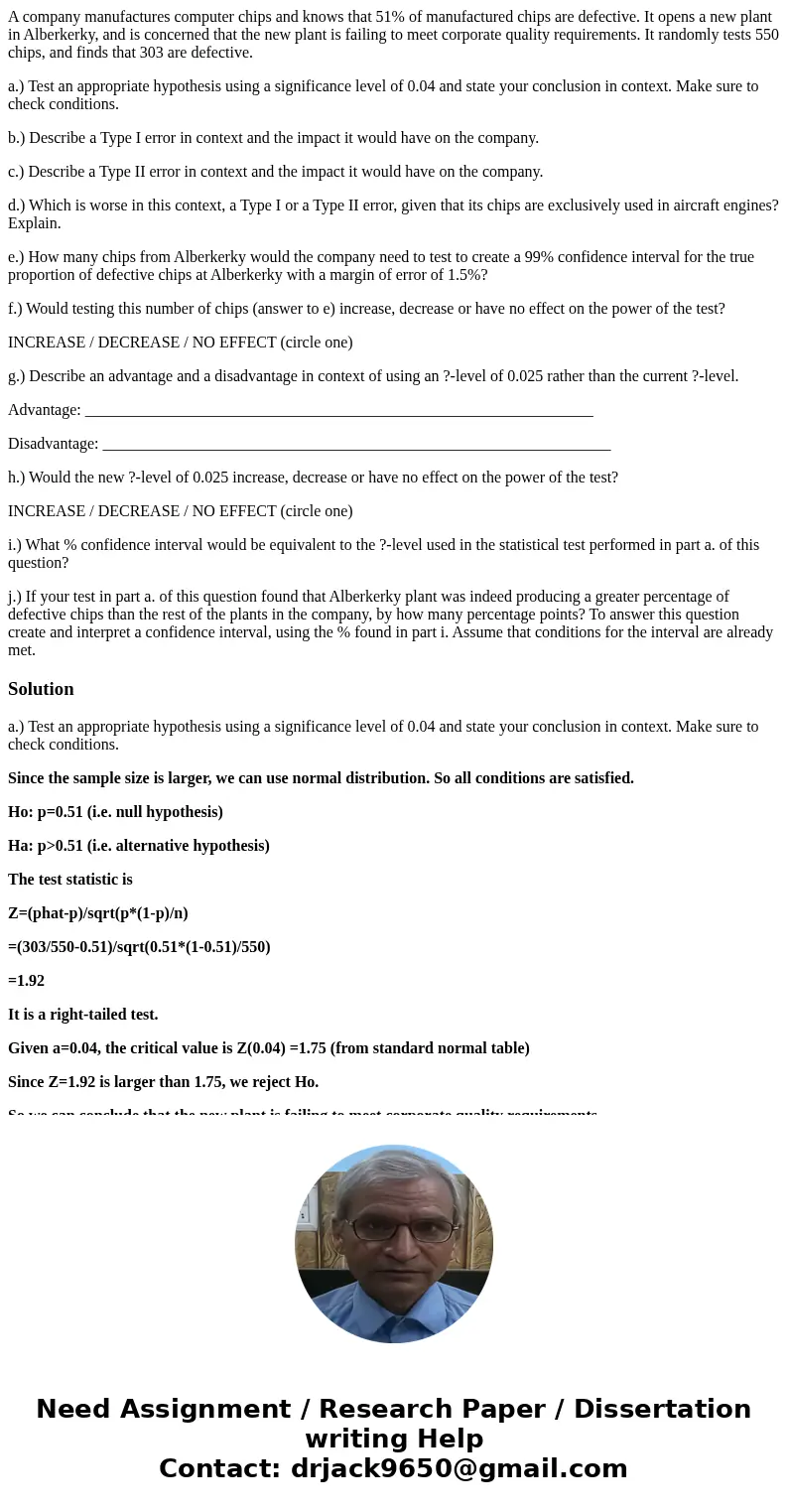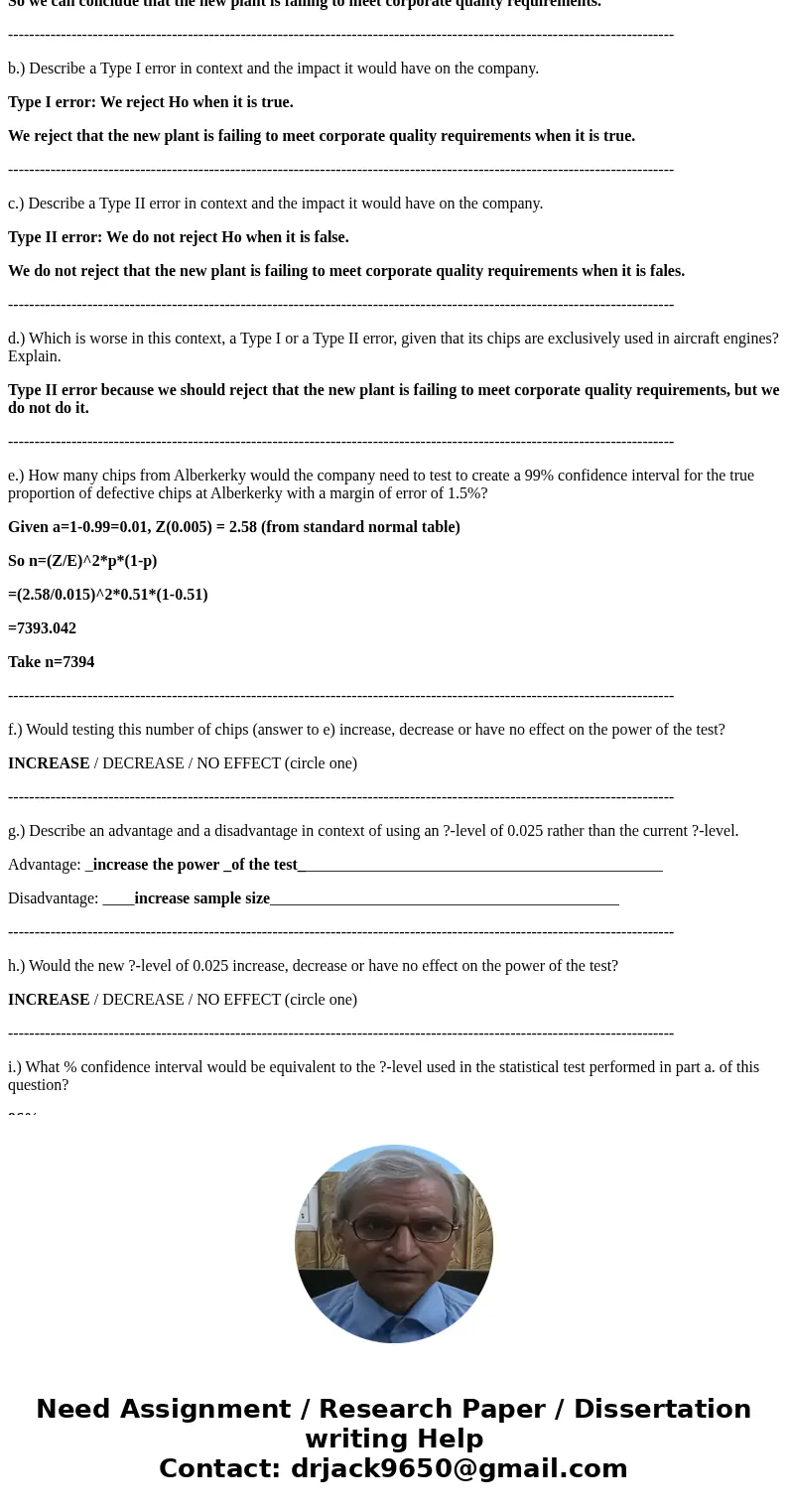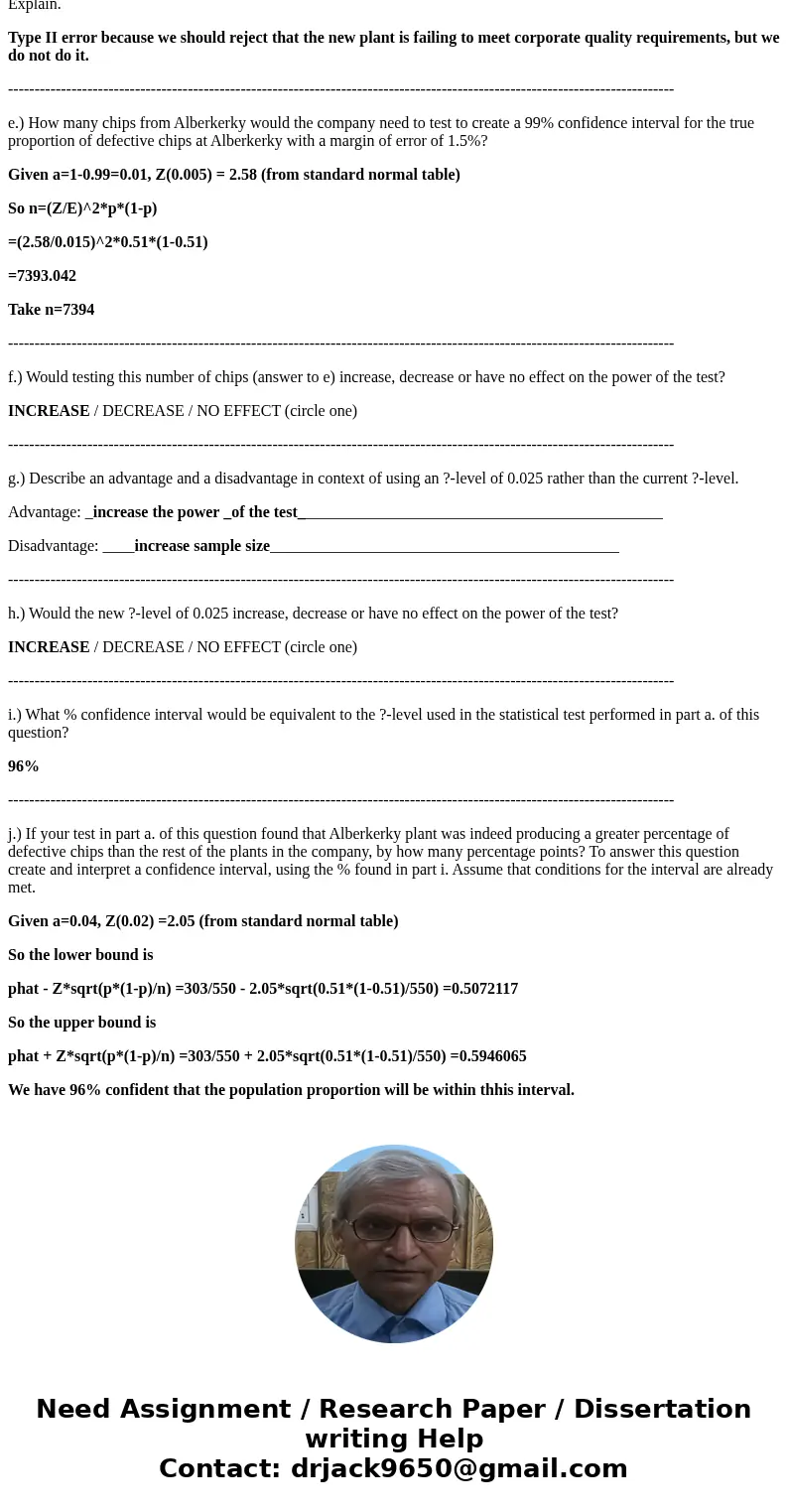A company manufactures computer chips and knows that 51 of m
A company manufactures computer chips and knows that 51% of manufactured chips are defective. It opens a new plant in Alberkerky, and is concerned that the new plant is failing to meet corporate quality requirements. It randomly tests 550 chips, and finds that 303 are defective.
a.) Test an appropriate hypothesis using a significance level of 0.04 and state your conclusion in context. Make sure to check conditions.
b.) Describe a Type I error in context and the impact it would have on the company.
c.) Describe a Type II error in context and the impact it would have on the company.
d.) Which is worse in this context, a Type I or a Type II error, given that its chips are exclusively used in aircraft engines? Explain.
e.) How many chips from Alberkerky would the company need to test to create a 99% confidence interval for the true proportion of defective chips at Alberkerky with a margin of error of 1.5%?
f.) Would testing this number of chips (answer to e) increase, decrease or have no effect on the power of the test?
INCREASE / DECREASE / NO EFFECT (circle one)
g.) Describe an advantage and a disadvantage in context of using an ?-level of 0.025 rather than the current ?-level.
Advantage: ________________________________________________________________
Disadvantage: ________________________________________________________________
h.) Would the new ?-level of 0.025 increase, decrease or have no effect on the power of the test?
INCREASE / DECREASE / NO EFFECT (circle one)
i.) What % confidence interval would be equivalent to the ?-level used in the statistical test performed in part a. of this question?
j.) If your test in part a. of this question found that Alberkerky plant was indeed producing a greater percentage of defective chips than the rest of the plants in the company, by how many percentage points? To answer this question create and interpret a confidence interval, using the % found in part i. Assume that conditions for the interval are already met.
Solution
a.) Test an appropriate hypothesis using a significance level of 0.04 and state your conclusion in context. Make sure to check conditions.
Since the sample size is larger, we can use normal distribution. So all conditions are satisfied.
Ho: p=0.51 (i.e. null hypothesis)
Ha: p>0.51 (i.e. alternative hypothesis)
The test statistic is
Z=(phat-p)/sqrt(p*(1-p)/n)
=(303/550-0.51)/sqrt(0.51*(1-0.51)/550)
=1.92
It is a right-tailed test.
Given a=0.04, the critical value is Z(0.04) =1.75 (from standard normal table)
Since Z=1.92 is larger than 1.75, we reject Ho.
So we can conclude that the new plant is failing to meet corporate quality requirements.
------------------------------------------------------------------------------------------------------------------------------
b.) Describe a Type I error in context and the impact it would have on the company.
Type I error: We reject Ho when it is true.
We reject that the new plant is failing to meet corporate quality requirements when it is true.
------------------------------------------------------------------------------------------------------------------------------
c.) Describe a Type II error in context and the impact it would have on the company.
Type II error: We do not reject Ho when it is false.
We do not reject that the new plant is failing to meet corporate quality requirements when it is fales.
------------------------------------------------------------------------------------------------------------------------------
d.) Which is worse in this context, a Type I or a Type II error, given that its chips are exclusively used in aircraft engines? Explain.
Type II error because we should reject that the new plant is failing to meet corporate quality requirements, but we do not do it.
------------------------------------------------------------------------------------------------------------------------------
e.) How many chips from Alberkerky would the company need to test to create a 99% confidence interval for the true proportion of defective chips at Alberkerky with a margin of error of 1.5%?
Given a=1-0.99=0.01, Z(0.005) = 2.58 (from standard normal table)
So n=(Z/E)^2*p*(1-p)
=(2.58/0.015)^2*0.51*(1-0.51)
=7393.042
Take n=7394
------------------------------------------------------------------------------------------------------------------------------
f.) Would testing this number of chips (answer to e) increase, decrease or have no effect on the power of the test?
INCREASE / DECREASE / NO EFFECT (circle one)
------------------------------------------------------------------------------------------------------------------------------
g.) Describe an advantage and a disadvantage in context of using an ?-level of 0.025 rather than the current ?-level.
Advantage: _increase the power _of the test______________________________________________
Disadvantage: ____increase sample size____________________________________________
------------------------------------------------------------------------------------------------------------------------------
h.) Would the new ?-level of 0.025 increase, decrease or have no effect on the power of the test?
INCREASE / DECREASE / NO EFFECT (circle one)
------------------------------------------------------------------------------------------------------------------------------
i.) What % confidence interval would be equivalent to the ?-level used in the statistical test performed in part a. of this question?
96%
------------------------------------------------------------------------------------------------------------------------------
j.) If your test in part a. of this question found that Alberkerky plant was indeed producing a greater percentage of defective chips than the rest of the plants in the company, by how many percentage points? To answer this question create and interpret a confidence interval, using the % found in part i. Assume that conditions for the interval are already met.
Given a=0.04, Z(0.02) =2.05 (from standard normal table)
So the lower bound is
phat - Z*sqrt(p*(1-p)/n) =303/550 - 2.05*sqrt(0.51*(1-0.51)/550) =0.5072117
So the upper bound is
phat + Z*sqrt(p*(1-p)/n) =303/550 + 2.05*sqrt(0.51*(1-0.51)/550) =0.5946065
We have 96% confident that the population proportion will be within thhis interval.



 Homework Sourse
Homework Sourse